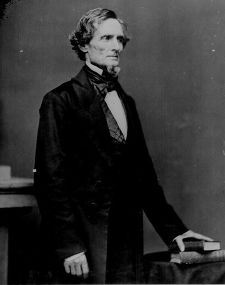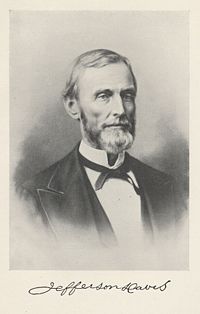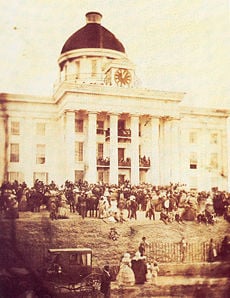Jefferson Davis
 From Nwe
From Nwe

|
|
|
|
|
| Term of office | February 18, 1861 – May 10, 1865 |
| Preceded by | None (Creation) |
| Succeeded by | None (Dissolution) |
| Date of birth | June 3, 1808 |
| Place of birth | Christian County, Kentucky |
| Date of death | December 6, 1889 |
| Place of death | New Orleans, Louisiana |
| Spouse | Sarah Knox Taylor (1st wife) Varina Howell (2nd wife) |
| Political party | Conservative (Southern) Democrat |
Jefferson F. Davis (June 3, 1808 – December 6, 1889) was an American statesman and advocate for slavery, most famous for serving as the only president of the Confederate States of America, leading the rebelling Southern slave states (the Confederate States) to defeat during the American Civil War, 1861–1865. Davis lacked the astute political skills of his counterpart Abraham Lincoln, and was unable to devise a successful military strategy in the face of the much larger and more industrially developed Union. His insistence on independence even in the face of crushing defeat prolonged the war. He was held for two years in federal prison after his capture in 1865, then released, with no charges being brought.
Before the Civil War, Davis served in the Mississippi legislature, the U.S. House of Representatives, and the U.S. Senate. He fought in the Mexican-American War as a colonel of a volunteer regiment. Later he became secretary of war in the cabinet of U.S. President Franklin Pierce.
Early life
Davis was born on a farm in Christian County, Kentucky, near the border with Todd County. (His birthplace is now the Jefferson Davis State Historic Site[1]). Davis was the last of the ten children of Samuel Emory Davis and his wife Jane. The family had a long tradition in American history. The younger Davis's grandfather immigrated to the United States from Wales and had once lived in Virginia and Maryland, working as a public servant. His father, along with his uncles, had served in the Continental Army during the American Revolutionary War; he fought with the Georgia cavalry and led in the Siege of Savannah as an infantry officer. His older brothers also served. During the War of 1812, three of Davis's brothers fought the British, two of them serving under Andrew Jackson and receiving his commendation for bravery in the Battle of New Orleans.
During Davis's youth, the family moved several times, in 1811 to Louisiana, and in 1812 to Mississippi. In 1813, Davis began his education together with his sister Mary, attending a log cabin school a mile from their home. Two years later, Davis entered the Catholic school. At the time, he was the only Protestant student.
Davis went on to Jefferson College at Washington, Mississippi, in 1818, and to Transylvania University at Lexington, Kentucky, in 1821. In 1824, Davis entered the United States Military Academy (West Point). He completed his four-year term as a West Point cadet, and was commissioned as a second lieutenant in June 1828, after he graduated.
Military career
Davis was first assigned to the 1st Infantry Regiment and was stationed at Fort Crawford, Wisconsin. His first assignment, in 1829, was to supervise the cutting of timber on the banks of the Red Cedar River for the repair and enlargement of the fort. Later that year, he was reassigned to Fort Winnebago. While supervising the construction and management of a sawmill in the Yellow River in 1831, he contracted pneumonia, causing him to return to Fort Crawford.
The next year, Davis was dispatched to Galena, Illinois at the head of a detachment assigned to remove miners from lands claimed by Native Americans. His first combat assignment was during the Black Hawk War of the same year, after which he was assigned by his colonel, Zachary Taylor, to escort Black Hawk himself to prison at Jefferson Barracks—it is said that the chief liked Davis because of the kind treatment he had shown. Another of Davis's duties during this time was to keep miners from illegally entering what would eventually become the state of Iowa.
In 1833, Davis was promoted to first lieutenant of the Regiment of Dragoons and made a regimental adjutant. In 1834, he was transferred to Fort Gibson in the Indian Territory.
Marriage, plantation life, and early political career


Davis fell in love with Colonel Taylor's daughter, Sarah Knox Taylor. Her father did not approve of the match, so Davis resigned his commission and married Miss Taylor on June 17, 1835. The marriage, however, proved to be short. While visiting Davis's oldest sister both newlyweds contracted malaria, and Davis's wife died three months after the wedding on September 15, 1835. In 1836, he moved to Brierfield Plantation in Warren County, Mississippi. For the next eight years, Davis was a recluse, studying government and history, and engaging in private political discussions with his brother Joseph.
While Davis was a slave owner, it is worth noting that Davis did not run his plantation in the manner of most southern slaveholders of the era. One of his favorite slaves was overseer of the plantation; justice was administered by slave "courts," which decided guilt or innocence for "crimes" and then decided punishments. These courts were free to choose a variety of punishments including a warning, extra labor, etc. Furthermore, slaves were allowed to grow their own food in their own personal gardens and were given chickens to collect eggs from which they were allowed to sell for a profit. They also were allowed to pick their own names instead of having them chosen for them. Although to modern mores this social arrangement would be considered paternalistic and condescending at best, Davis's treatment of his slaves was uncommon and considered benevolent by white society in the antebellum South. Regardless, Davis supported the idea of slavery.
The subsequent years proved uneventful, as Davis supervised the production of cotton at Brierfield, and studied political science. He decided to put his studies to use in 1843, by entering a career in politics. He ran for the Mississippi House of Representatives as a Democrat, and engaged in a debate with his opponent, Seargent Smith Prentiss, on election day. However, Davis's efforts proved unsuccessful, and he lost the election. The next year, he traveled around Mississippi campaigning for James K. Polk and George M. Dallas in the presidential election of 1844.
In 1844, Davis saw his first political success, as he was elected to the United States House of Representatives, taking office on March 4 of the following year.
He married again on February 26, 1845, this time to the socially prominent Varina Howell.
Second military career

At the beginning of the Mexican-American War, Davis resigned his House seat in June 1846, and raised a volunteer regiment, the Mississippi Rifles, becoming its colonel. On July 21, they sailed from New Orleans for the Texas coast.
This regiment was of particular note in that Davis armed it with percussion rifles and trained the regiment in their use, making the regiment particularly effective in combat.
In September of the same year, he participated in the successful siege of Monterrey, Mexico. He fought bravely at Buena Vista, Mexico on February 22, 1847, and was shot in the foot. In recognition of his bravery and initiative, commanding general Zachary Taylor is reputed to have said, "My daughter, sir, was a better judge of men than I was."
President James K. Polk offered him a federal commission as a brigadier general and command of a brigade of militia. He declined the appointment, arguing that the United States Constitution gives the power of appointing militia officers to the states, and not to the federal government.
Because of his war service, the governor of Mississippi appointed Davis to fill out the Senate term of the late Jesse Speight. He took his seat December 5, 1847, and was elected to serve the remainder of his term in January 1848. In addition, the Smithsonian Institution appointed him a regent at the end of December 1847.
Return to politics
The Senate made Davis chairman of the Committee on Military Affairs. When his term expired, he was elected to the same seat (by the Mississippi legislature, as the Constitution mandated at the time). He had not served a year when he resigned (in September 1851) to run for the governorship of Mississippi on the issue of the Compromise of 1850, which Davis opposed. This election bid was unsuccessful, as he was defeated by Henry Stuart Foote by 999 votes.
Left without political office, Davis continued his political activity. He took part in a convention on states' rights, held at Jackson, Mississippi in January 1852. In the weeks leading up to the presidential election of 1852, he campaigned in a number of Southern states for Democratic candidates Franklin Pierce and William R. King.
Pierce won the election and made Davis his secretary of war. In this capacity, Davis gave to Congress four annual reports, as well as an elaborate one on various routes for the proposed Transcontinental Railroad. The Pierce administration ended in 1857. The president lost the Democratic nomination, which went instead to James Buchanan. Davis's term was to end with Pierce's, so he ran successfully for the Senate, and re-entered it on March 4, 1857.
On February 2, 1860, as secessionist clamor in the South grew, Davis submitted six resolutions in an attempt to consolidate opinion regarding states' rights, including the right to maintain slavery in the South, and to further his own position on the issue. Abraham Lincoln won the presidency that November. Matters came to a head, and South Carolina seceded from the Union.
Though an opponent of secession in principle, Davis upheld it in practice on January 10, 1861. On January 21, 1861, he announced the secession of Mississippi, delivered a farewell address, and resigned from the Senate.
Leadership of the Confederacy

Four days after his resignation, Davis was commissioned as major general of Mississippi troops. On February 9, 1861, a constitutional convention at Montgomery, Alabama named him provisional president of the Confederate States of America and he was inaugurated on February 18. In meetings of his own Mississippi legislature, Davis had argued against secession; but relented when a majority of the delegates opposed him.
In conformity with a resolution of the Confederate Congress, Davis immediately appointed a Peace Commission to resolve the Confederacy's differences with the Union. In March 1861, before the bombardment of Fort Sumter, the commission was to travel to Washington, D.C., to offer to pay for any Federal property on Southern soil as well as the Southern portion of the national debt, but it was not authorized to discuss terms for reunion. He appointed General P. G. T. Beauregard to command Confederate troops in the vicinity of Charleston, South Carolina. The government moved to Richmond, Virginia in May 1861, and Davis and his family took up his residence there at the White House of the Confederacy on May 29.

Davis was elected to a six-year term as president of the Confederacy on November 6, 1861. He had never served a full term in any elective office and this turned out to be no exception.
He was inaugurated on February 22, 1862. On June 1, he assigned General Robert E. Lee to command the Army of Northern Virginia, the main Confederate army in the Eastern Theater. That December, he made a tour of Confederate armies in the west of the country. In August 1863, Davis declined General Lee's offer of resignation after his defeat at the Battle of Gettysburg. As Confederate military fortunes turned for the worse in 1864, he visited Georgia with the intent of raising morale.
Davis has received criticism over his conduct of the military affairs of the Confederacy. Until late in the war, he resisted efforts to appoint a general-in-chief, essentially handling those duties himself; on January 31, 1865, Lee assumed this role, but it was far too late. Davis insisted on a strategy of trying to defend all Southern territory with ostensibly equal effort, which diluted the limited resources of the South and made it vulnerable to coordinated strategic thrusts by the Union into the vital Western Theater, such as the capture of New Orleans. He made other poor strategic choices, such as allowing Lee to invade the North on two occasions while the Western armies were under very heavy pressure. Davis has been faulted for poor coordination and management of his generals. This includes his reluctance to relieve his personal friend, Braxton Bragg, defeated in important battles and distrusted by his subordinates; he relieved the cautious but capable Joseph E. Johnston and replaced him with the reckless John Bell Hood, resulting in the loss of Atlanta and the eventual loss of an army.
On April 3, 1865, with Union troops under Ulysses S. Grant poised to capture Richmond, Davis escaped for Danville, Virginia, together with the Confederate cabinet, leaving on the Richmond and Danville Railroad. He issued his last official proclamation as president of the Confederacy then fled south to Greensboro, North Carolina. On May 10, he was captured at Irwinville, Georgia.
Cabinet
| OFFICE | NAME | TERM |
| President | Jefferson Davis | |
| Vice President | Alexander Stephens | 1861–1865 |
| Secretary of State]|align="left"|Robert Toombs | 1861 | |
| Robert M.T. Hunter | 1861–1862 | |
| William M. Browne | 1862 | |
| Judah P. Benjamin | 1862–1865 | |
| Secretary of the Treasury | Christopher Memminger | 1861–1864 |
| George Trenholm | 1864–1865 | |
| Secretary of War | Leroy Pope Walker | 1861 |
| Judah P. Benjamin | 1861–1862 | |
| George W. Randolph | 1862 | |
| Gustavus Smith | 1862 (Acting) | |
| James Seddon | 1862–1865 | |
| John C. Breckinridge | 1865 | |
| Secretary of the Navy | Stephen Mallory | 1861–1865 |
| Postmaster General | John H. Reagan | 1861–1865 |
| Attorney General | Judah P. Benjamin | 1861 |
| Thomas Bragg | 1861–1862 | |
| Thomas Watts | 1862–1864 | |
| George Davis | 1864–1865 | |
Imprisonment and retirement
On May 19, 1865, he was imprisoned in a casemate at Fortress Monroe, on the coast of Virginia. The casemate was wet, unheated, and open to the weather, leading many to believe that his captors intended him to die in prison. He was placed in irons on the 23rd, but released from irons on the 26th at the recommendation of a physician. Davis was not indicted for treason until a year later (May 1866) due to the constitutional concerns of United States Supreme Court Chief Justice Salmon P. Chase.
While in prison, Davis arranged to sell his Mississippi estate to one of his former slaves, Ben Montgomery. Montgomery was a talented business manager, mechanic, and even an inventor who had become wealthy in part from running his own general store.
The next year, after imprisonment of two years, he was released on bail that was posted by prominent citizens of both northern and southern states, including Horace Greeley and Cornelius Vanderbilt, who had become convinced he was being treated unfairly. He visited Canada, and sailed for New Orleans, Louisiana, via Havana, Cuba. In 1868, he traveled to Europe. That December, the court rejected a motion to nullify the indictment, but the prosecution dropped the case in February 1869.
That same year, Davis became president of the Carolina Life Insurance Company in Memphis, Tennessee. Upon Robert E. Lee's death in 1870, Davis presided over the memorial meeting in Richmond. Elected to the U.S. Senate again, he refused the office in 1875, having been barred from federal office by the Fourteenth Amendment to the United States Constitution.
In 1876, he promoted a society for the stimulation of U.S. trade with South America. Davis visited England the next year, returning in 1878 to Mississippi. Over the next three years there, Davis wrote The Rise and Fall of the Confederate Government. Having completed that book, he visited Europe again, and traveled to Alabama and Georgia the following year.
He completed A Short History of the Confederate States of America in October 1889. Two months later, Davis died in New Orleans at the age of 81. His funeral was one of the largest ever staged in the South and ran a continuous march from New Orleans to Richmond, Virginia day and night. He is buried at Hollywood Cemetery in Richmond, Virginia.
A monument to Jefferson Davis was unveiled on June 3, 1907, on Monument Avenue in Richmond, Virginia.
Section 3 of the Fourteenth Amendment to the United States Constitution barred from office anyone who had violated their oath to protect the Constitution by serving in the Confederacy. That prohibition included Davis. In 1978, pursuant to authority granted to Congress under the same section of the Amendment, Congress posthumously removed the ban on Davis with a two-thirds vote of each house and President Jimmy Carter signed it. These actions were spearheaded by Congressman Trent Lott of Mississippi. Congress had previously taken similar action on behalf of Robert E. Lee.
The state of Alabama celebrates Davis' birthday on the first Monday in June. The state of Mississippi observes Davis' birthday in conjunction with the Memorial Day Federal holiday.
Notes
- ↑ Kentucky Department of Parks – Jefferson Davis Monument State Historic Site Retrieved May 10, 2007.
References
ISBN links support NWE through referral fees
- Ballard, Michael B. A Long Shadow: Jefferson Davis and the Final Days of the Confederacy. Athens, GA: University of Georgia Press, 1997. ISBN 9780820319414
- Cooper, William J. Jefferson Davis, American. New York: Alfred A. Knopf, 2000. ISBN 9780394569161
- Davis, Jefferson. Jefferson Davis: The Essential Writings. Ed. William J. Cooper. New York: Modern Library, 2003. ISBN 9780679642527
- Davis, Jefferson. The Rise and Fall of the Confederate Government. New York: Da Capo Press, 1990. ISBN 9780306804182
- Davis, William C. Jefferson Davis: The Man and His Hour. New York: HarperCollins, 1991. ISBN 9780060167066
- Dodd, William E. Jefferson Davis. Lincoln: University of Nebraska Press, 1997. ISBN 9780803266094
- Eaton, Clement. Jefferson Davis. New York: Free Press, 1977. ISBN 9780029087008
- Escott, Paul D. After Secession: Jefferson Davis and the Failure of Confederate Nationalism. Baton Rouge: Louisiana State University Press, 1978. ISBN 9780807103692
- Monroe, Haskell M., James T. McIntosh, and Lynda L. Crist, eds. The Papers of Jefferson Davis. Baton Rouge: Louisiana State University Press, 1991. ISBN 9780807109434
- Thomas, Emory M. The Confederate Nation, 1861–1865. New York: Harper and Row, 1979. ISBN 9780060142520
External links
All links retrieved July 30, 2022.
- The Papers of Jefferson Davis at Rice University
Credits
New World Encyclopedia writers and editors rewrote and completed the Wikipedia article in accordance with New World Encyclopedia standards. This article abides by terms of the Creative Commons CC-by-sa 3.0 License (CC-by-sa), which may be used and disseminated with proper attribution. Credit is due under the terms of this license that can reference both the New World Encyclopedia contributors and the selfless volunteer contributors of the Wikimedia Foundation. To cite this article click here for a list of acceptable citing formats.The history of earlier contributions by wikipedians is accessible to researchers here:
- Jefferson Davis history
The history of this article since it was imported to New World Encyclopedia:
- History of "Jefferson Davis"
Note: Some restrictions may apply to use of individual images which are separately licensed.
↧ Download as ZWI file | Last modified: 02/03/2023 23:31:09 | 14 views
☰ Source: https://www.newworldencyclopedia.org/entry/Jefferson_Davis | License: CC BY-SA 3.0
 ZWI signed:
ZWI signed: KSF
KSF